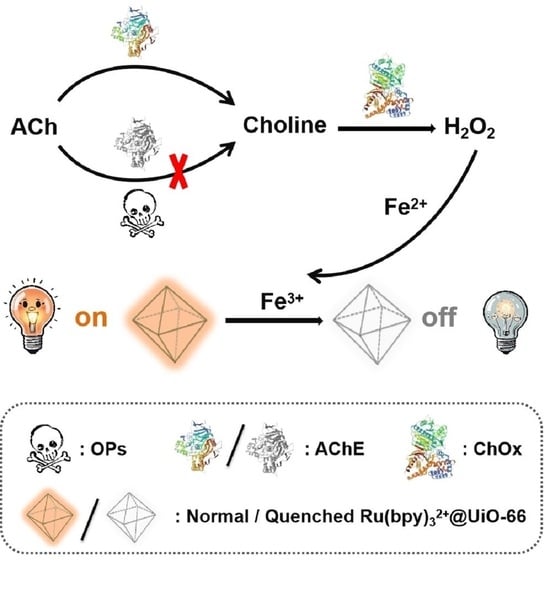A Turn-On Fluorescence Sensor Based on Guest-Induced Luminescence Ru(bpy)32+@UiO-66 for the Detection of Organophosphorus Pesticides
Abstract
1. Introduction
2. Results and Discussion
2.1. Characterization of UiO-66 and Ru(bpy)32+@UiO-66
2.2. Optical Properties of Ru(bpy)32+@UiO-66
2.3. Feasibility of Ru(bpy)32+@UiO-66 Sensor for OP Sensing
2.4. Detection of OPs
2.5. Anti-Interference Ability, Selectivity and Recyclability
2.6. Detection of OPs in Actual Samples
3. Materials and Methods
3.1. Reagents and Instruments
3.2. Synthesis of UiO-66
3.3. Preparation of Ru(bpy)32+@UiO-66
3.4. Fluorometric Detection of OPs
3.5. OP Detection in Real Samples
4. Conclusions
Author Contributions
Funding
Institutional Review Board Statement
Informed Consent Statement
Data Availability Statement
Conflicts of Interest
References
- Pundir, C.S.; Malik, A. Bio-sensing of organophosphorus pesticides: A review. Biosens. Bioelectron. 2019, 140, 111348. [Google Scholar] [CrossRef]
- Farag, A.; Gamila, A.; Kotb, G.; Hamza, A.; Hussein, R.; Elhalwagy, M. Impact of Organophosphorus insecticide Triazophos on Liver, Kidneys and Thyroid in Albino Rats. Int. J. Adv. Res. Biol. Sci. 2016, 3, 199–208. [Google Scholar]
- Pehkonen, S.O.; Zhang, Q. The degradation of organophosphorus pesticides in natural waters: A critical review. Crit. Rev. Environ. Sci. Technol. 2002, 32, 17–72. [Google Scholar] [CrossRef]
- Legierse, K.C.H.M.; Verhaar, H.J.M.; Vaes, W.H.J.; De Bruijn, J.H.M.; Hermens, J.L.M. Analysis of the time-dependent acute aquatic toxicity of organophosphorus pesticides: The critical target occupation model. Environ. Sci. Technol. 1999, 33, 917–925. [Google Scholar] [CrossRef]
- Sun, J.F.; Guo, L.; Bao, Y.; Xie, J.W. A simple, label-free AuNPs-based colorimetric ultrasensitive detection of nerve agents and highly toxic organophosphate pesticide. Biosens. Bioelectron. 2011, 28, 152–157. [Google Scholar] [CrossRef] [PubMed]
- Yu, C.C.; Hao, D.Y.; Chu, Q.; Wang, T.; Liu, S.N.; Lan, T.; Wang, F.H.; Pan, C.P. A one adsorbent QuEChERS method coupled with LC-MS/MS for simultaneous determination of 10 organophosphorus pesticide residues in tea. Food Chem. 2020, 321, 126657. [Google Scholar] [CrossRef]
- Peyrovi, M.; Hadjmohammadi, M. Alkanol-based supramolecular solvent microextraction of organophosphorus pesticides and their determination using high-performance liquid chromatography. J. Iran. Chem. Soc. 2017, 14, 995–1004. [Google Scholar] [CrossRef]
- Manav, Ö.G.; Dinç-Zor, Ş.; Alpdoğan, G. Optimization of a modified QuEChERS method by means of experimental design for multiresidue determination of pesticides in milk and dairy products by GC-MS. Microchem. J. 2019, 144, 124–129. [Google Scholar] [CrossRef]
- Cheng, Z.P.; Dong, F.S.; Xu, J.; Liu, X.G.; Wu, X.H.; Chen, Z.L.; Pan, X.L.; Gan, J.; Zheng, Y.Q. Simultaneous determination of organophosphorus pesticides in fruits and vegetables using atmospheric pressure gas chromatography quadrupole-time-of-flight mass spectrometry. Food Chem. 2017, 231, 365–373. [Google Scholar] [CrossRef]
- Liu, B.; Ge, Y.; Zhang, Y.; Song, Y.; Lv, Y.Y.; Wang, X.X.; Wang, S. Production of the class-specific antibody and development of direct competitive ELISA for multi-residue detection of organophosphorus pesticides. Food Agric. Immunol. 2012, 23, 157–168. [Google Scholar] [CrossRef]
- Hua, X.D.; Liu, X.F.; Shi, H.Y.; Wang, Y.R.; Kim, H.J.; Gee, S.J.; Wang, M.H.; Liu, F.Q.; Hammock, B.D. Development of a heterologous enzyme-linked immunosorbent assay for organophosphorus pesticides with phage-borne peptide. RSC Adv. 2014, 4, 42445–42453. [Google Scholar] [CrossRef]
- Soulis, D.; Trigazi, M.; Tsekenis, G.; Chandrinou, C.; Klinakis, A.; Zergioti, I. Facile and Low-Cost SPE Modification Towards Ultra-Sensitive Organophosphorus and Carbamate Pesticide Detection in Olive Oil. Molecules 2020, 25, 4988. [Google Scholar] [CrossRef]
- Guo, W.; Chen, Z.Y.; Zhao, Y.X.; Zhao, C.Y.; Lu, X.; Gao, F.M. Hierarchical Cu3V2O8/Cu6Mo5O18/MXene nanostructures by ultrathin nanosheets for highly sensitive electrochemical detection of organophosphorus pesticides. Microchem. J. 2024, 201, 110601. [Google Scholar] [CrossRef]
- Tian, J.X.; Gong, S.; Gu, Y.; Li, Z.N.; Liang, Y.Y.; Meng, Z.Y.; Wang, Z.L.; Wang, S.F. A novel nopinone-based fluorescent probe for sensitive detection of pesticide parathion-methyl in soil and its applications in biological imaging. J. Environ. Chem. Eng. 2025, 13, 116193. [Google Scholar] [CrossRef]
- Dong, J.J.; Yang, H.T.; Li, Y.; Liu, A.R.; Wei, W.; Liu, S.Q. Fluorescence sensor for organophosphorus pesticide detection based on the alkaline phosphatase-triggered reaction. Anal. Chim. Acta 2020, 1131, 102–108. [Google Scholar] [CrossRef]
- Cai, Y.; Qiu, Z.Y.; Lin, X.B.; Zeng, W.; Cao, Y.R.; Lin, W.P.; Liu, Y.J. Self-assembled nanomaterials based on aggregation-induced emission of AuNCs: Fluorescence and colorimetric dual-mode biosensing of organophosphorus pesticides. Sens. Actuators B Chem. 2020, 321, 128281. [Google Scholar] [CrossRef]
- Wu, X.L.; Wang, P.S.; Hou, S.Y.; Wu, P.L.; Xue, J. Fluorescence sensor for facile and visual detection of organophosphorus pesticides using AIE fluorogens-SiO2-MnO2 sandwich nanocomposites. Talanta 2019, 198, 8–14. [Google Scholar] [CrossRef] [PubMed]
- Wu, X.L.; Song, Y.; Yan, X.; Zhu, C.Z.; Ma, Y.Q.; Du, D.; Lin, Y.H. Carbon quantum dots as fluorescence resonance energy transfer sensors for organophosphate pesticides determination. Biosens. Bioelectron. 2017, 94, 292–297. [Google Scholar] [CrossRef] [PubMed]
- Yan, X.; Song, Y.; Zhu, C.Z.; Li, H.X.; Du, D.; Su, X.G.; Lin, Y.H. MnO2 nanosheet-carbon dots sensing platform for sensitive detection of organophosphorus pesticides. Anal. Chem. 2018, 90, 2618–2624. [Google Scholar] [CrossRef] [PubMed]
- Chen, J.L.; Chen, X.J.; Wang, P.; Liu, S.W.; Chi, Z.G. Aggregation-induced emission luminogen@manganese dioxide core-shell nanomaterial-based paper analytical device for equipment-free and visual detection of organophosphorus pesticide. J. Hazard. Mater. 2021, 413, 125306. [Google Scholar] [CrossRef]
- Li, H.H.; Ali, S.; Wei, W.Y.; Xu, Y.; Lu, H.W.; Mehedi Hassan, M.; Wu, X.Y.; Zuo, M.; Ouyang, Q.; Chen, Q.S. Rapid detection of organophosphorus in tea using NaY/GdF4: Yb, Er-based fluorescence sensor. Microchem. J. 2020, 159, 105462. [Google Scholar] [CrossRef]
- Lin, X.F.; Yu, Q.R.; Yang, W.; He, C.X.; Zhou, Y.; Duan, N.; Wu, S.J. Double-enzymes-mediated fluorescent assay for sensitive determination of organophosphorus pesticides based on the quenching of upconversion nanoparticles by Fe3+. Food Chem. 2021, 345, 128809. [Google Scholar] [CrossRef] [PubMed]
- Furukawa, H.; Cordova, K.E.; OâTMKeeffe, M.; Yaghi, Q.M. The chemistry and applications of metal-organic frameworks. Science 2013, 341, 974. [Google Scholar] [CrossRef] [PubMed]
- Li, J.R.; Kuppler, R.J.; Zhou, H.C. Selective gas adsorption and separation in metal-organic frameworks. Chem. Soc. Rev. 2009, 38, 1477–1504. [Google Scholar] [CrossRef]
- Daglar, H.; Gulbalkan, H.C.; Avci, G.; Aksu, G.O.; Altundal, O.F.; Altintas, C.; Erucar, I.; Keskin, S. Effect of metal-organic framework (MOF) database selection on the assessment of gas storage and separation potentials of MOFs. Angew. Chem. Int. Ed. 2021, 60, 7828–7837. [Google Scholar] [CrossRef]
- Lv, X.L.; Wang, K.C.; Wang, B.; Su, J.; Zou, X.D.; Xie, Y.B.; Li, J.B.; Zhu, H.C. A base-resistant metalloporphyrin metal-organic framework for C-H bond halogenation. J. Am. Chem. Soc. 2017, 139, 211–217. [Google Scholar] [CrossRef]
- Lee, J.Y.; Farha, O.K.; Roberts, J.; Scheidt, K.A.; Nguyen, J.T. Metal-organic framework materials as catalysts. Chem. Soc. Rev. 2009, 38, 1450–1459. [Google Scholar] [CrossRef]
- Ji, L.D.; Wang, J.; Wu, K.B.; Yang, N.J. Tunable Electrochemistry of Electrosynthesized Copper Metal-Organic Frameworks. Adv. Funct. Mater. 2018, 28, 1706961. [Google Scholar] [CrossRef]
- Hu, A.Q.; Pang, Q.Q.; Tang, C.; Bao, J.X.; Liu, H.Q.; Ba, K.; Xie, S.H.; Chen, J.; Chen, J.H.; Yue, Y.W.; et al. Epitaxial growth and integration of insulating metal-organic frameworks in electrochemistry. Chem. Soc. 2019, 141, 11322–11327. [Google Scholar] [CrossRef]
- Horcajada, P.; Gref, R.; Baati, T.; Allan, P.K.; Maurin, G.; Couvreur, P.; Férey, G.; Morris, R.E.; Serre, C. Metal-organic frameworks in biomedicine. Chem. Rev. 2012, 112, 1232. [Google Scholar] [CrossRef]
- Zhang, Y.; Wang, F.M.; Liu, C.Q.; Wang, Z.Z.; Kang, L.H.; Huang, Y.Y.; Dong, K.; Ren, J.S.; Qu, X.G. Nanozyme Decorated Metal-Organic Frameworks for Enhanced Photodynamic Therapy. ACS Nano 2018, 12, 651–661. [Google Scholar] [CrossRef]
- Gu, Z.Y.; Yang, C.X.; Chang, N.; Yan, X.D. Metal-Organic Frameworks for Analytical Chemistry: From Sample Collection to Chromatographic Separation. Acc. Chem. Res. 2012, 45, 734–745. [Google Scholar] [CrossRef]
- Yin, H.Q.; Yang, J.C.; Yin, X.B. Ratiometric fluorescence sensing and real-time detection of water in organic solvents with one-pot synthesis of Ru@MIL-101(Al)-NH2. Anal. Chem. 2017, 89, 13434–13440. [Google Scholar] [CrossRef] [PubMed]
- Xu, X.H.; Guo, Y.N.; Wang, X.Y.; Li, W.; Qi, P.P.; Wang, Z.W.; Wang, X.Q.; Gunasekaram, S.; Wang, Q. Sensitive detection of pesticides by a highly luminescent metal-organic framework. Sens. Actuators B Chem. 2018, 260, 339–345. [Google Scholar] [CrossRef]
- Yang, W.K.; Yang, Y.H.; Li, H.H.; Lin, D.Y.; Yang, W.T.; Guo, D.Y.; Pan, Q.H. Integration of Cd: ZnS QDs into ZIF-8 for enhanced selectivity toward Cu2+ detection. Inorg. Chem. Front. 2020, 7, 3718–3726. [Google Scholar] [CrossRef]
- Zhou, H.C.; Long, J.R.; Yaghi, O.M. Introduction to metal-organic frameworks. Chem. Rev. 2012, 112, 673–674. [Google Scholar] [CrossRef]
- Abdelhamid, H.N. UiO-66 as a catalyst for hydrogen production via the hydrolysis of sodium borohydride. Dalton Trans. 2020, 49, 10851–10857. [Google Scholar] [CrossRef]
- Zheng, L.; Li, Q.; Deng, X.K.; Guo, Q.F.; Liu, D.D.; Nie, G.M. A novel electrochemiluminescence biosensor based on Ru(bpy)32+-functionalized MOF composites and cycle amplification technology of DNAzyme walker for ultrasensitive detection of kanamycin. J. Colloid Interf. Sci. 2024, 659, 859–867. [Google Scholar] [CrossRef]
- Fukuto, T.R. Mechanism of Action of Organophosphorus and Carbamate Insecticides. Environ. Health Persp. 1990, 87, 245–254. [Google Scholar] [CrossRef]
- Fatma, N.K.; Faruk, B.; Vasif, H. Construction of an acetylcholinesterase-choline oxidase biosensor for aldicarb determination. Biosens. Bioelectron. 2002, 17, 531–539. [Google Scholar]
- Wu, L.; Zhou, M.; Liu, C.; Chen, X.; Chen, Y. Double-enzymes-mediated Fe2+/Fe3+ conversion as magnetic relaxation switch for pesticide residues sensing. J. Hazard. Mater. 2021, 403, 123619. [Google Scholar] [CrossRef]
- Xiao, Z.C.; Li, Y.; Nie, Y.L.; Lu, L.Q.; Yang, C. A Cu2+-triggered turn-on fluorescence non-enzymatic probe based on covalent organic framework for the detection of methyl parathion. Anal. Chim. Acta 2025, 1346, 343775. [Google Scholar] [CrossRef]
- Zhang, H.Y.; Li, J.; Xiang, Q.; Liu, S.N.; Chen, Z.H.; Zhu, S.W.; Wu, Y.Z.; Qian, Y.; Yang, D.Z.; Ma, Y.S. A ratiometric fluorescence probe based on dual quantum dots for methyl parathion detection in agricultural products. Microchem. J. 2024, 197, 109733. [Google Scholar] [CrossRef]
- Yan, X.; Li, H.X.; Wang, X.Y.; Su, X.G. A novel fluorescence probing strategy for the determination of parathion-methyl. Talanta 2015, 131, 88–94. [Google Scholar] [CrossRef]
- Yang, Y.Y.; Tong, X.; Chen, Y.X.; Zhou, R.R.; Cai, G.H.; Wang, T.T.; Zhang, S.H.; Shi, S.Y.; Guo, Y. A dual-emission carbon dots-based nonenzymatic fluorescent sensing platform for simultaneous detection of parathion-methyl and glyphosate. Food Chem. 2023, 403, 134346. [Google Scholar] [CrossRef]
- Zhang, R.T.; Zhang, L.Y.; Yu, R.Z.; Wang, C.Y. Rapid and sensitive detection of methyl parathion in rice based on carbon quantum dots nano-fluorescence probe and inner filter effect. Food Chem. 2023, 413, 135679. [Google Scholar] [CrossRef] [PubMed]
- Li, Y.; Wan, M.; Yan, G.; Qiu, P.; Wang, X.L. A dual-signal sensor for the analysis of parathion-methyl using silver nanoparticles modified with graphitic carbon nitride. J. Pharm. Anal. 2021, 11, 183–190. [Google Scholar] [CrossRef] [PubMed]
- Song, W.; Zhang, H.J.; Liu, Y.H.; Ren, C.L.; Chen, H.L. A new fluorescence probing strategy for the detection of parathion-methyl based on N-doped carbon dots and methyl parathion hydrolase. Chin. Chem. Lett. 2017, 28, 1675–1680. [Google Scholar] [CrossRef]
- Vyas, T.; Jaiswal, S.; Choudhary, S.; Kodgire, P.; Joshi, A. Recombinant Organophosphorus acid anhydrolase (OPAA) enzyme-carbon quantum dot (CQDs)-immobilized thin film biosensors for the specific detection of Ethyl Paraoxon and Methyl Parathion in water resources. Environ. Res. 2024, 243, 117855. [Google Scholar] [CrossRef]
- Huang, S.; Yao, J.; Chu, X.; Liu, Y.; Xiao, Q.; Zhang, Y. One-step facile synthesis of nitrogen-doped carbon dots: A ratiometric fluorescent probe for evaluation of acetylcholinesterase activity and detection of organophosphorus pesticides in tap water and food. J. Agr. Food Chem. 2019, 67, 11244–11255. [Google Scholar] [CrossRef]
- Wang, S.Z.; McGuirk, C.M.; Ross, M.B.; Wang, S.Y.; Chen, P.C.; Xing, H.; Liu, Y.; Mirkin, C.A. General and direct method for preparing oligonucleotide-functionalized metal-organic framework nanoparticles. J. Am. Chem. Soc. 2017, 139, 9827–9830. [Google Scholar] [CrossRef]
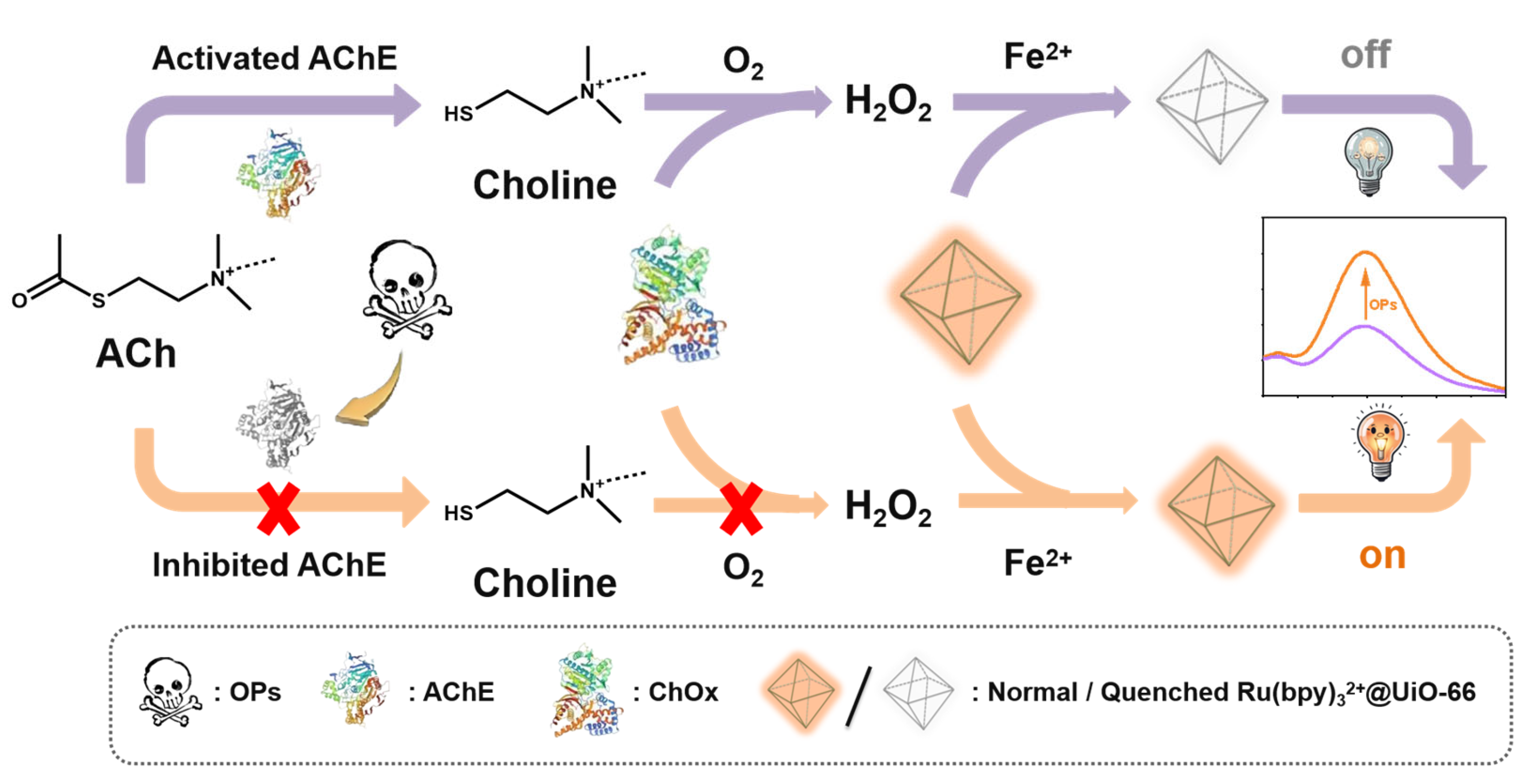

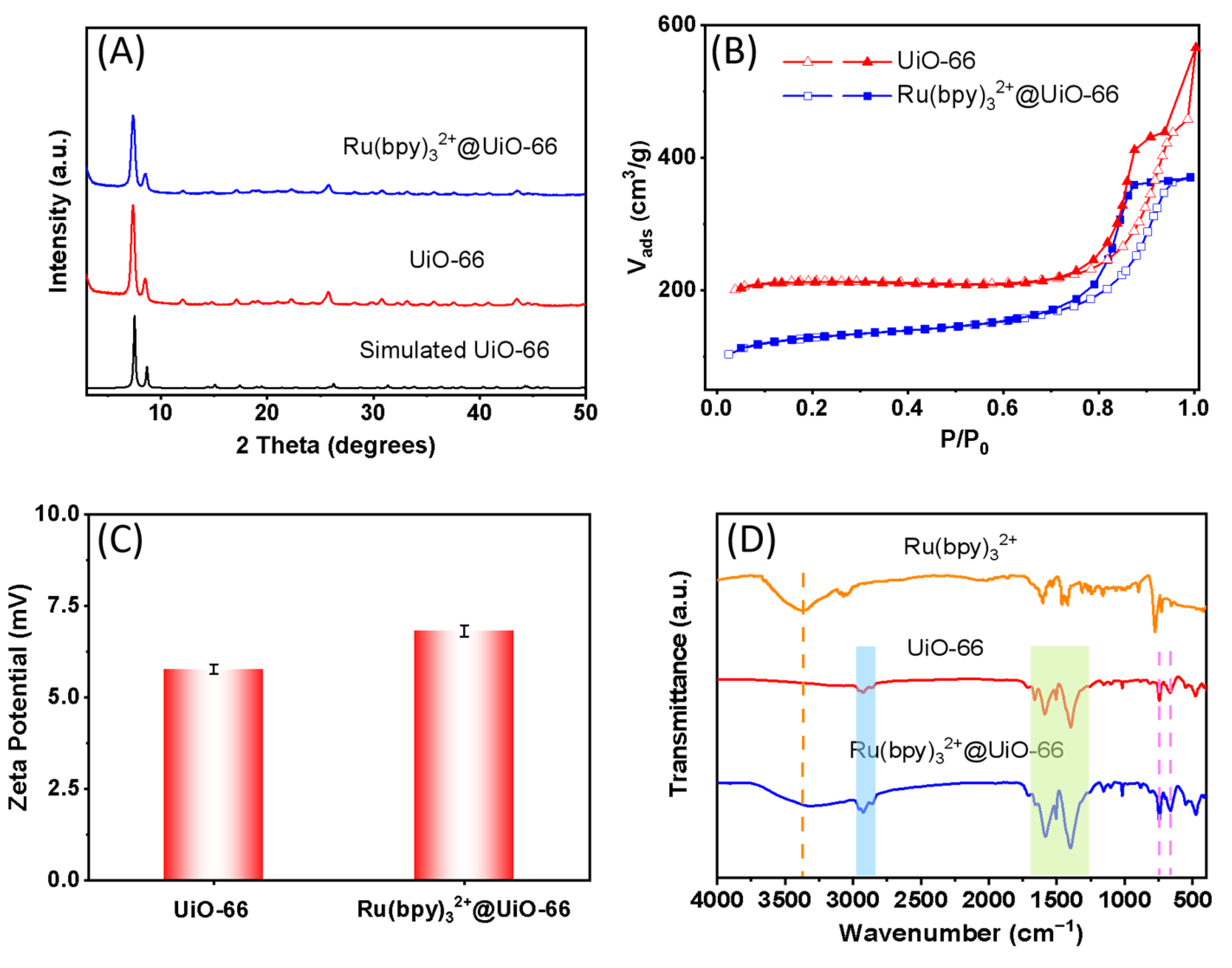

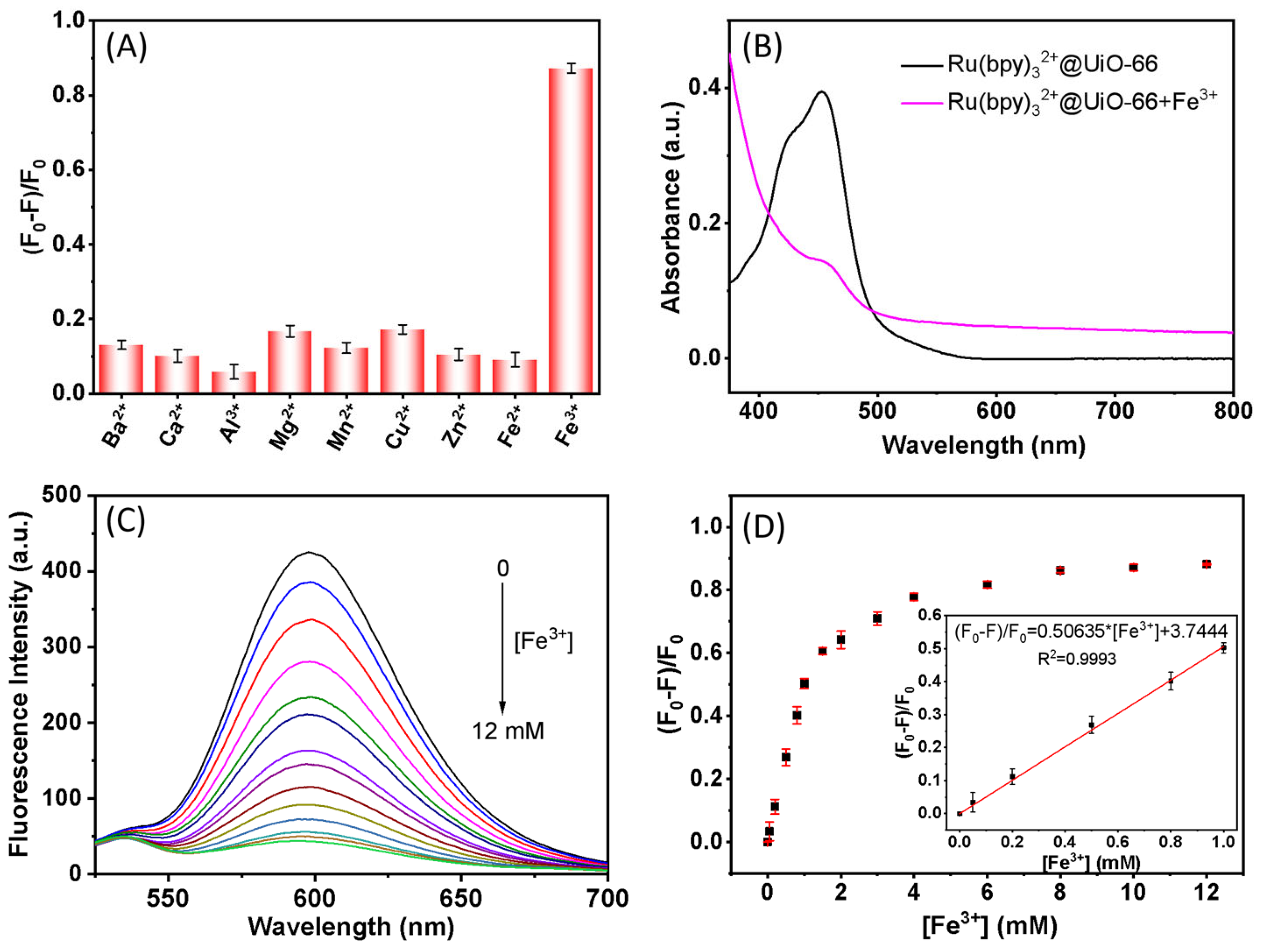

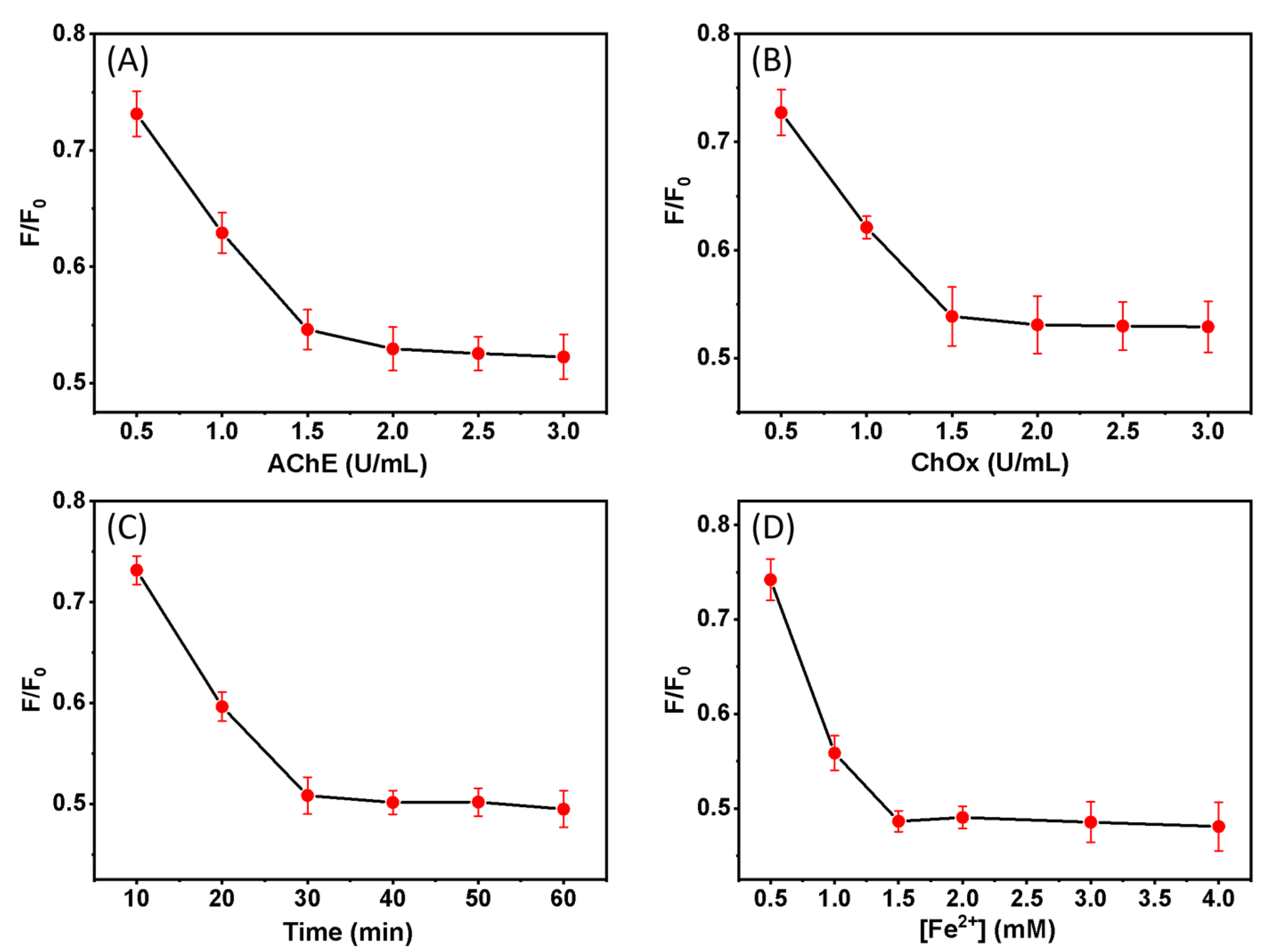
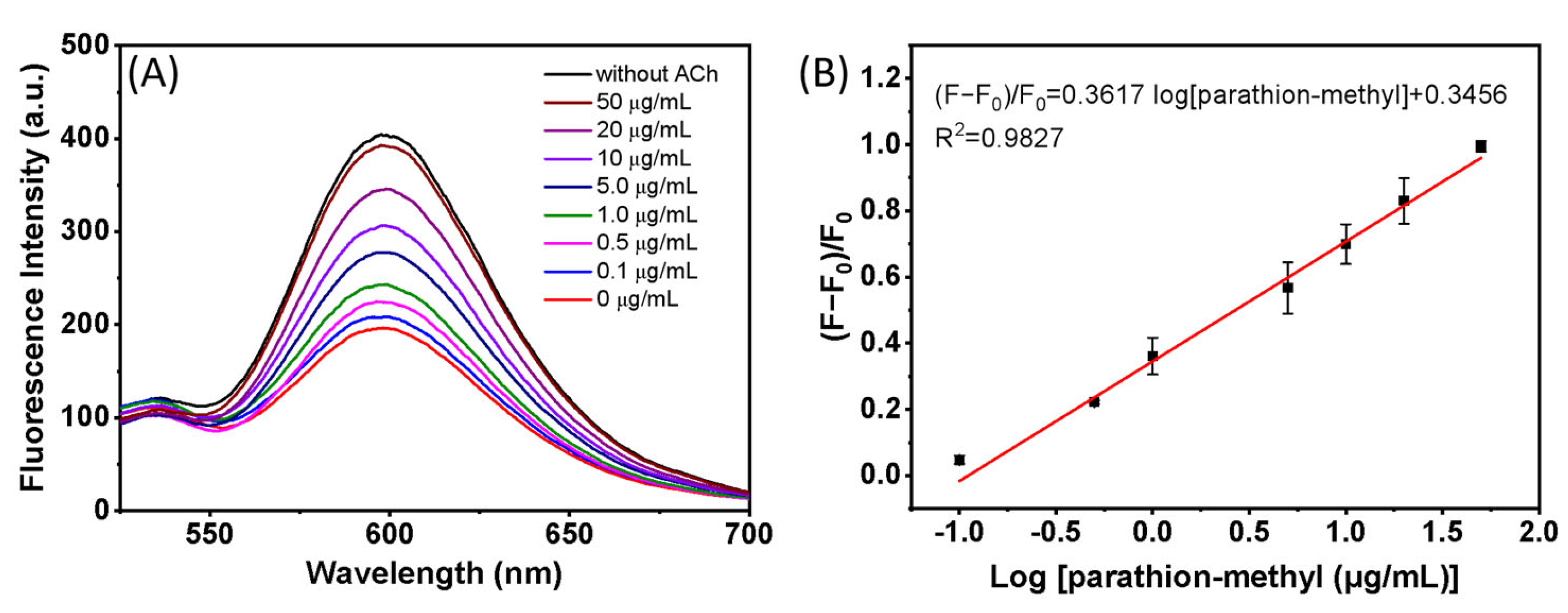

| Probe | Linear Range (μg/mL) | Detection Limit (ng/mL) | Reference |
|---|---|---|---|
| THIP-OCP | 0–450.0 | 790.0 | [14] |
| Cu2+/TAPB-DMTA-COF | 0.1474–1.437 | 8.080 | [42] |
| β-CD-MoS2 QDs | 0.05000–25.00 | 32.00 | [43] |
| CdTe QDs | 0.02500–3.000 | 18.00 | [44] |
| bCDs | 0.07896–17.11 | 36.85 | [45] |
| CQDs-NFP | 0.005000–14.00 | -- | [46] |
| g-C3N4/AgNPs | 100.0–1000 | 3.240 × 104 | [47] |
| N-doped carbon dots | 626.4–1.942 × 104 | 8.900 × 104 | [48] |
| OPAA-CQDs | 0–26.30 | 684.4 | [49] |
| N-CDs-DAP | -- | 13.00 | [50] |
| Ru(bpy)32+@UiO-66 | 0.1000–50.00 | 10.60 | This work |
| Sample | Spiked (μg/mL) | Found (μg/mL) | Recovery (%) | RSD (n = 3, %) |
|---|---|---|---|---|
| Lake water | 0 | Not found | — | — |
| 5.000 | 5.340 | 106.8 | 3.1 | |
| 10.00 | 10.34 | 103.4 | 4.3 | |
| 15.00 | 15.07 | 100.5 | 4.7 | |
| Tap water | 0 | Not found | — | — |
| 5.000 | 4.640 | 92.80 | 2.9 | |
| 10.00 | 10.54 | 105.4 | 2.4 | |
| 15.00 | 14.78 | 98.53 | 4.3 | |
| Cabbage | 0 | Not found | — | — |
| 5.000 | 4.680 | 93.60 | 5.6 | |
| 10.00 | 10.06 | 100.6 | 1.0 | |
| 15.00 | 15.04 | 100.3 | 4.2 |
Disclaimer/Publisher’s Note: The statements, opinions and data contained in all publications are solely those of the individual author(s) and contributor(s) and not of MDPI and/or the editor(s). MDPI and/or the editor(s) disclaim responsibility for any injury to people or property resulting from any ideas, methods, instructions or products referred to in the content. |
© 2025 by the authors. Licensee MDPI, Basel, Switzerland. This article is an open access article distributed under the terms and conditions of the Creative Commons Attribution (CC BY) license (https://creativecommons.org/licenses/by/4.0/).
Share and Cite
Li, J.; Deng, J.; Tao, Q.; Yan, C.; Liu, Y.; Yang, J.; Cao, Z. A Turn-On Fluorescence Sensor Based on Guest-Induced Luminescence Ru(bpy)32+@UiO-66 for the Detection of Organophosphorus Pesticides. Molecules 2025, 30, 3130. https://doi.org/10.3390/molecules30153130
Li J, Deng J, Tao Q, Yan C, Liu Y, Yang J, Cao Z. A Turn-On Fluorescence Sensor Based on Guest-Induced Luminescence Ru(bpy)32+@UiO-66 for the Detection of Organophosphorus Pesticides. Molecules. 2025; 30(15):3130. https://doi.org/10.3390/molecules30153130
Chicago/Turabian StyleLi, Jun, Jianlan Deng, Qian Tao, Chenyu Yan, Yuxuan Liu, Jianxiao Yang, and Zhong Cao. 2025. "A Turn-On Fluorescence Sensor Based on Guest-Induced Luminescence Ru(bpy)32+@UiO-66 for the Detection of Organophosphorus Pesticides" Molecules 30, no. 15: 3130. https://doi.org/10.3390/molecules30153130
APA StyleLi, J., Deng, J., Tao, Q., Yan, C., Liu, Y., Yang, J., & Cao, Z. (2025). A Turn-On Fluorescence Sensor Based on Guest-Induced Luminescence Ru(bpy)32+@UiO-66 for the Detection of Organophosphorus Pesticides. Molecules, 30(15), 3130. https://doi.org/10.3390/molecules30153130






